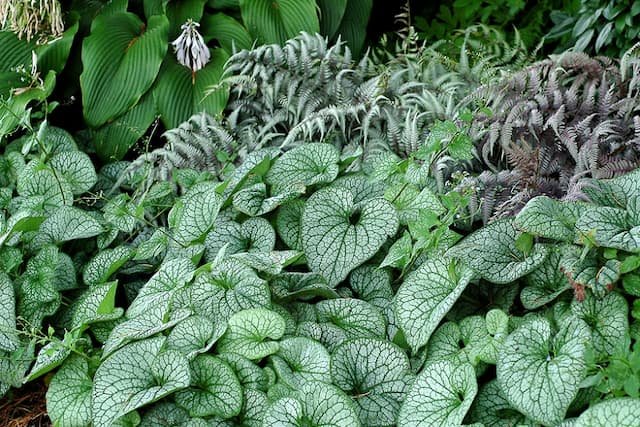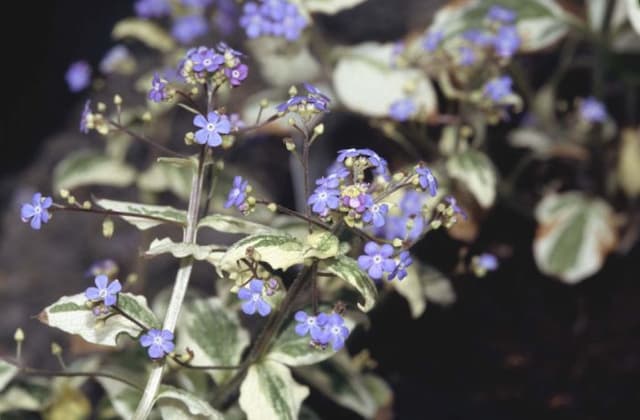Creeping Forget-me-not Omphalodes verna

ABOUT
Omphalodes verna, commonly known as creeping navelwort, is a perennial plant that is cherished for its beautiful early spring flowers. Its foliage consists of lush green, heart-shaped leaves that create a low-growing spread over the ground. The name "navelwort" partially derives from the navel-like centers of the leaves. The leaves attach to the stems with little to no stalk. The true charm of the creeping navelwort comes from its delicate flowers. The blossoms are small and shaped like open bells or cups. A classic feature is their striking blue color, which adds a vibrant splash to the early spring landscape. Each flower consists of five petals, which are fused at the base forming the characteristic bell shape. These petals fan out elegantly at the mouth of the bell. In full bloom, creeping navelwort has a whimsical and enchanting presence. The flowers are often profuse, covering the plant in a carpet of blue, reminiscent of a miniature sky spread across the forest floor. The contrast of the rich green leaves and the blue flowers creates a picturesque scene ideal for woodland gardens, rock gardens, or as a ground cover. This plant typically thrives in shady to semi-shady areas, flourishing under the canopies of larger plants, making it a favorite for gardeners looking for ground-cover options in shaded parts of the garden. Despite its delicate appearance, it is a hardy plant that once established, requires minimal care, making it a popular choice among both novice and experienced gardeners. Its springtime display is a much-anticipated sight that signals the end of winter's dormancy.
About this plant
 Names
NamesSynonyms
Blue-Eyed-Mary, Creeping Forget-Me-Not, Mountain Bugloss, Naval Wort, Venus's Navelwort, Woodland Forget-Me-Not
Common names
Cynoglossum omphalodes, Omphalodes linifolia
 Toxicity
ToxicityTo humans
Omphalodes verna, commonly known as Creeping Forget-Me-Not, is not widely recognized as a toxic plant to humans. There is little to no documented evidence suggesting significant toxicity in humans upon ingestion. However, as with any plant, individual allergies or sensitivities can occur, and it is generally advisable not to ingest plants that are not known to be edible.
To pets
Creeping Forget-Me-Not (Omphalodes verna) is not commonly listed as a toxic plant to pets such as dogs and cats. There is limited information on its toxicity level; therefore, it is always best to err on the side of caution and prevent pets from ingesting this or any unknown plants as they might cause gastrointestinal upset or an allergic reaction in some pets. If a pet displays unusual symptoms after ingestion, it is recommended to consult a veterinarian.
 Characteristics
CharacteristicsLife cycle
Perennials
Foliage type
Evergreen
Color of leaves
Green
Flower color
Blue
Height
6 inches (15 cm)
Spread
1 foot (30 cm)
Plant type
Herb
Hardiness zones
4
Native area
Europe
Benefits
 General Benefits
General Benefits- Attracts pollinators: Omphalodes verna, commonly known as creeping navelwort, draws bees and other pollinating insects which is beneficial for garden biodiversity.
- Ground cover: It forms a dense mat which can suppress weeds and cover bare spots in the garden.
- Shade tolerance: It thrives in shaded areas where many other plants struggle, making it useful for planting under trees and in other shaded environments.
- Spring blooms: With its bright blue flowers, creeping navelwort provides early season color to gardens when not much else is blooming.
- Low maintenance: Once established, it requires little care beyond occasional watering and can thrive with minimal intervention.
- Erosion control: Its spreading habit and the dense coverage it provides can help prevent soil erosion in sloped areas of the garden.
- Drought resistance: After establishing, creeping navelwort is fairly drought tolerant, which can be beneficial in drier climates or during water restrictions.
 Medical Properties
Medical PropertiesThis plant is not used for medical purposes.
 Air-purifying Qualities
Air-purifying QualitiesThis plant is not specifically known for air purifying qualities.
 Other Uses
Other Uses- Omphalodes verna, commonly known as creeping navelwort, can be used as a natural dye for fabrics, providing a range of blue and green hues depending on the mordant used.
- The leaves of creeping navelwort can be infused in water to create a soothing wash for cleaning delicate surfaces or items without leaving streaks or residues.
- Intricate patterns or children's crafts can be created by using the rounded leaves of creeping navelwort to stamp paint onto various surfaces.
- Culinary artists sometimes use the small, blue flowers of creeping navelwort as an edible decoration to add a splash of color to salads and desserts.
- The plant serves as a natural ground cover, preventing soil erosion on slopes or in areas where grass has difficulty growing.
- Harvested creeping navelwort stems can be woven into tiny wreaths or decorative shapes to be used in fairy gardens or as part of natural table settings.
- Pressed and dried Omphalodes verna flowers can be used in scrapbooking or to create botanical art preserving the memory of a garden throughout the year.
- Dried and crushed leaves of Omphalodes verna can act as a natural filler for sachets imparting a subtle, earthy fragrance to linens and clothing.
- The dense foliage of creeping navelwort can be used in terrariums, providing a lush, miniature landscape for small figurines or other artistic displays.
- Children can engage in a gentle introduction to gardening by planting creeping navelwort due to its hardy nature and low maintenance requirements.
Interesting Facts
 Feng Shui
Feng ShuiThe plant Blue-eyed Mary is not used in Feng Shui practice.
 Zodiac Sign Compitability
Zodiac Sign CompitabilityThe plant Blue-eyed Mary is not used in astrology practice.
 Plant Symbolism
Plant Symbolism- Forgetfulness: Omphalodes verna is commonly known as the "forget-me-not," and traditionally, these flowers have been used as a symbol of remembrance, both in a positive and sorrowful sense. Its symbolism of forgetfulness is more paradoxical, as it actually encourages not to forget.
- True Love: The forget-me-not's charming and delicate appearance has made it a representation of true and faithful love, symbolizing a deep and enduring connection between individuals.
- Remembrance: With its common name suggesting a plea for remembrance, this plant is often associated with memories and is frequently used in situations where remembering someone or something is important, such as gifts or memorials.
- Faithful Return: This symbol is derived from legends and historical use; the forget-me-not is thought to represent the hope for loved ones to return and for friends to keep their connections despite distance or time apart.
- Protection: In some folklore, the forget-me-not has been believed to offer protection to wearers, guarding them against misfortune and ensuring their safe return.
 Water
WaterFor the creeping navelwort, it's essential to maintain a consistent moisture level in the soil without overwatering. This plant prefers evenly moist soil; therefore, watering once a week with about one gallon of water per square yard should be sufficient. During the hot summer months, you may need to water the creeping navelwort twice a week if the soil dries out quickly. However, in the cooler seasons or if the plant is in a shadier spot, reducing watering to every other week might be necessary. Always check the top inch of soil for dryness before watering to ensure the plant is not overwatered, as this could lead to root rot.
 Light
LightCreeping navelwort thrives best in partial shade but can tolerate full shade conditions. It's ideal for a spot that receives dappled sunlight throughout the day or bright, indirect light. Direct afternoon sun should be avoided as it can scorch the leaves. This makes creeping navelwort perfect for woodland gardens or areas under the light canopy of trees where it can receive the light it needs without being exposed to harsh sunlight.
 Temperature
TemperatureCreeping navelwort performs well in a range of temperatures and is hardy in USDA zones 4 to 8. It can tolerate minimum temperatures down to -30°F and maximum temperatures well into the 80s°F. The ideal temperature conditions for creeping navelwort are between 50°F and 70°F. Winter hardiness allows it to survive cold spells, while during the hot temperatures, it appreciates being in a cooler, shaded location.
 Pruning
PruningPruning creeping navelwort is mainly done to remove dead or damaged foliage and to maintain a tidy growth habit. Light pruning can be performed in the spring to remove winter-damaged leaves and encourage new growth. After flowering, it's beneficial to trim back the spent flower stems to encourage a second bloom and prevent the plant from self-seeding too widely. Major pruning is rarely necessary; just keep an eye out for any unhealthy-looking growth to trim away.
 Cleaning
CleaningAs needed
 Soil
SoilCreeping forget-me-not (Omphalodes verna) prefers well-draining soil rich in organic matter with a pH range of 6.5 to 7.5. A good soil mix for this plant would be one part garden soil, one part compost or peat moss, and one part perlite or coarse sand. This combination ensures moisture retention while still providing adequate drainage to prevent root rot.
 Repotting
RepottingCreeping forget-me-nots are not typically repotted often as they are perennial ground cover plants. They can be lifted and divided every 3 to 5 years to rejuvenate growth and manage their spread. When repotting, do so in the spring or early autumn.
 Humidity & Misting
Humidity & MistingCreeping forget-me-nots thrive in average to moist humidity levels but don't require any specific humidity conditions to grow successfully. Ensure the location is not overly dry; a typical outdoor environment usually provides sufficient humidity for these plants.
 Suitable locations
Suitable locationsIndoor
Keep Creeping forget-me-not in indirect light, evenly moist soil.
Outdoor
Plant in partial shade, moist, well-drained soil, divide every 3-5 years.
Hardiness zone
4-9 USDA
 Life cycle
Life cycleOmphalodes verna, commonly known as creeping navelwort or blue-eyed Mary, begins its life cycle as a seed, germinating in moist, well-drained soil during early spring. After germination, the seedling emerges, developing a rosette of green leaves. As the plant matures, it produces stems that grow low to the ground and spread, forming a mat-like ground cover. Flowering occurs in late spring to early summer, with Omphalodes verna producing small, bright blue flowers with a white center, resembling forget-me-nots. After pollination, typically by insects, the flowers develop into seed capsules, which eventually release seeds, completing the plant's reproductive cycle. During the colder months, the plant dies back but can reemerge from the root system in the following spring, continuing its perennial lifecycle.
 Propogation
PropogationPropogation time
Spring to early summer
Omphalodes verna, commonly known as creeping forget-me-not, can be propagated through seed sowing. The best time to sow seeds is in either the spring or the autumn. To propagate by seed, one should evenly distribute the seeds on the surface of a well-draining seed starting mix and gently press them into the soil, as they need light to germinate. Ensure the soil remains moist but not waterlogged. Germination can be expected in approximately two to four weeks at temperatures between 65 to 70 degrees Fahrenheit (18 to 21 degrees Celsius). Transplant the seedlings into individual pots once they are large enough to handle, and later move them to their final position in the garden after the risk of frost has passed.









